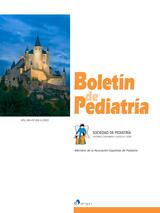Análisis factorial confirmatorio del cuestionario sobre hábitos saludables en adolescentes ENHASA
P.J. Carpena Lucas , F. Sánchez-Cubo , M. Vargas Vargas
Bol. Pediatr. 2022; 62 (260): 93 - 102
Introducción. Las cifras de sobrepeso y obesidad durante la infancia y la adolescencia están creciendo a un ritmo alarmante. Además, se han descrito diferencias en los estilos de vida entre chicos y chicas. Detectar a los individuos con riesgo de desarrollar exceso de peso es imprescindible para un diagnóstico precoz y una intervención temprana que evite la aparición de comorbilidades. Para ello es de vital importancia disponer de instrumentos de cribado de calidad, debidamente analizados. Material y métodos. Se aplicó el cuestionario de Hábitos Saludables en Adolescentes (ENHASA) a una muestra de estudiantes de primer curso de educación secundaria obligatoria (ESO) de la Región de Murcia. Se obtuvo además la somatometría y se clasificaron según IMC. Se realizó análisis factorial confirmatorio (AFC) según género para valorar las propiedades psicométricas de la encuesta. Resultados. La muestra final fue de 416 alumnos, de los que el 40,6% presentó exceso de peso; no habiendo diferencias entre sexos. El 28,2% del total reflejó hábitos mejorables; obteniendo las peores puntuaciones en las dimensiones actividad física y uso de nuevas tecnologías. El KMO fue de 0,729 en chicos y de 0,725 en chicas; y la varianza total explicada fue del 61,57% y 62,92%, respectivamente. El AFC mostró concordancia estructural con respecto al análisis factorial exploratorio previo en ambos sexos. Conclusiones. Dos de cada 5 adolescentes de la muestra presentó exceso de peso. Se confirma que ENHASA es un cuestionario válido y fiable que puede utilizarse como método de cribado en la práctica clínica.
Confirmatory factor analysis of the healthy habits questionnaire in adolescents ENHASA
Introduction. The numbers of overweight and obesity during childhood and adolescence are growing at an alarming rate. In addition, differences in the lifestyles between boys and girls have been described. Detecting individuals at risk of developing excess weight is essential to carry out an early diagnosis and early intervention, and thus avoid the appearance of comorbidity. For this, it is vitally important to have quality screening instruments, duly analyzed. Methods. We applied the Healthy Habits in Adolescents (ENHASA) questionnaire to a sample of students in the first year of secondary education in the Region of Murcia. Somatometry was also obtained and classified according to BMI. Confirmatory factor analysis (CFA) was performed according to gender to assess the psychometric properties of the survey. Results. The final sample was 416 students, of which 40.6% were overweight or obesity; there being no differences between the sexes. 28.2% of the total reflected habits that could be improved; obtaining the worst scores in the dimensions of physical activity and use of new technologies. The KMO was 0.729 in boys and 0.725 in girls; and the total explained variance was 61.57% and 62.92% respectively. The CFA showed structural agreement with respect to the previous exploratory factor analysis in both sexes. Conclusion. 2 out of 5 adolescents in the sample were excess of weight. ENHASA is confirmed to be a valid and reliable questionnaire that can be used as a screening method in clinical practice
Artículo completo (PDF) (159 kb.)
- Otros
Buscar en el boletín
Año 2022, Volumen 62, Número 260

Boletín completo en PDF (8748 kb.)